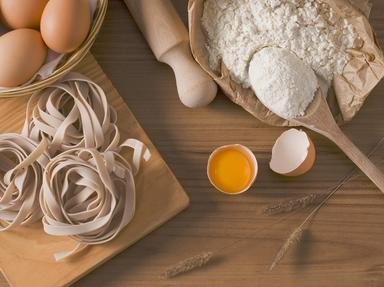Quiz Answer Key and Fun Facts
1. To begin, we have a little breakfast. One of life's great pleasures is the soft boiled egg. Traditionally, the way to cook it is to boil it for three minutes, but Chef Blumenthal states that it is too risky. So for the first step, place a medium sized egg in a small pot of cold water. Let it go on the highest temperature, and once the water boils, what's the next step to perfection?
2. Continuing with the breakfast theme, we have another morning classic, scrambled eggs. Heston visits the town hall to check on how some ladies make their scrambled eggs. There are four techniques, and one of them is done by Heston, but which one is it?
3. Let's get cracking with another classic egg dish, the great poached egg. Many myths of getting that perfect poached egg are all the rage, but Heston only mentions one simple thing to getting it right, a fresh egg.
True or false: a fresh egg sinks in water, while an old egg floats.
4. One of the great mother sauces, mayonnaise is next. This has no twist involved, but Heston wants to demonstrate a simple misconception. Many believe that it is very easy to split mayonnaise when you add too much oil in one go. To emulsify, which of these ingredients will help mix the water in the egg and the oil?
5. Let's take it up a notch: Heston challenges himself to make a scotch egg. But this is not like any scotch egg, this is one that has a runny yolk in the center. The first step is to half boil the egg. After half boiling, you need to stop it from cooking any further. How do you stop it from cooking?
6. Now, we have semi-cooked eggs, but there's still the meaty casing, breadcrumbs and cooking to go! I want to ask you though, after boiling these eggs, which method(s) does Heston use to finish cooking the meat totally?
7. This next recipe is a personal favourite of mine. Heston always wanted to make the ultimate lemon tart, perfecting the tart and removing the guesswork in making it. To begin, we must blind bake the puff pastry. Usually, baking beans are used to prevent the puff pastry from rising, but Heston has a somewhat...bonkers item to use in place of it.
True or false: Heston recommends using coins to help blind bake the pastry.
8. The biggest form of guesswork is in the setting of the custard. Normally, they ask to wobble the tart to see if the lemon custard has set, but it is such a vague test. Heston has it all sorted, and that is by using his best mate. Which of these will help him measure the 'heat' of the tart?
9. And now for something completely different, breakfast, but for dessert. Don't adjust your monitor, you are seeing it right. It's Heston's bacon & egg ice cream, and this will boggle your mind. To start, instead of using a commercial ice cream machine, what does he want us to use? A hint, it's super cold, and is made from carbon dioxide.
10. We have eggs in the ice cream mixture, and that's a given. But how do you add that bacon flavour in it without placing chunks of crispy rashers in that smooth ice cream?
True or false: Heston infuses bacon in the milk and cream mixture overnight.
Source: Author
Abby_91
This quiz was reviewed by FunTrivia editor
WesleyCrusher before going online.
Any errors found in FunTrivia content are routinely corrected through our feedback system.
